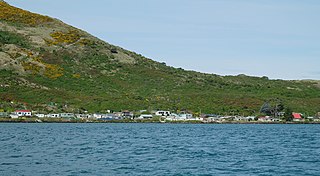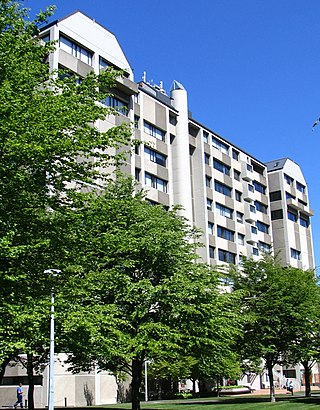
The Otago Peninsula is a long, hilly indented finger of land that forms the easternmost part of Dunedin, New Zealand. Volcanic in origin, it forms one wall of the eroded valley that now forms Otago Harbour. The peninsula lies south-east of Otago Harbour and runs parallel to the mainland for 20 km, with a maximum width of 9 km. It is joined to the mainland at the south-west end by a narrow isthmus about 1.5 km wide.

Portobello is a village beside the Otago Harbour halfway along the Otago Peninsula in Dunedin City, New Zealand. It lies at the foot of a small peninsula between Portobello Bay and Latham Bay.

Otago Harbour is the natural harbour of Dunedin, New Zealand, consisting of a long, much-indented stretch of generally navigable water separating the Otago Peninsula from the mainland. They join at its southwest end, 21 km (13 mi) from the harbour mouth. It is home to Dunedin's two port facilities, Port Chalmers and at Dunedin's wharf. The harbour has been of significant economic importance for approximately 700 years, as a sheltered harbour and fishery, then deep water port.

Hocken Collections (Māori: Uare Taoka o Hākena, formerly the Hocken Library) is a research library, historical archive, and art gallery based in Dunedin, New Zealand. Its library collection, which is of national significance, is administered by the University of Otago.

The Dunedin School of Medicine is the name of the School of Medicine that is based on the Dunedin campus of the University of Otago. All University of Otago medical students who gain entry after the competitive Health Sciences First Year program, or who gain graduate entry, spend their second and third years studying at the Otago Medical School in Dunedin. In their fourth, fifth, and sixth years, students can either study at the Dunedin School of Medicine (Dunedin), the University of Otago, Christchurch, or the University of Otago, Wellington.
The University of Otago College of Education is a teacher-training facility that is part of the University of Otago in Dunedin, New Zealand. It was formed on 1 January 2007 through a merger of the University of Otago's Faculty of Education with the Dunedin College of Education. The College of Education's main campus is in Dunedin but has a satellite campus in Invercargill.

Logan Park is a sporting venue in the city of Dunedin, New Zealand. It lies on land reclaimed from the former Lake Logan.

The Toitū Otago Settlers Museum is a regional history museum in Dunedin, New Zealand. Its brief covers the territory of the old Otago Province, that is, New Zealand from the Waitaki River south, though its main focus is the city of Dunedin. It is New Zealand's oldest history museum.

The settlement of Harington Point lies within the boundaries of the city of Dunedin, New Zealand. It is located at the Otago Heads, at the northeastern end of Otago Peninsula, close to the entrance of Otago Harbour. The mouth of the harbour is at its narrowest at Harington Point, only some 400 metres separating the point from the mudflats at Aramoana on the opposing coast.

The Robert Stout Law Library is the law library of the University of Otago in the city of Dunedin in New Zealand. It is named in honour of Sir Robert Stout, the first lecturer in law at Otago (1873-1876). Following his time at Otago, Stout went on to serve as Attorney-General, Premier, and Chief Justice of New Zealand.

Saint Margaret's College, Otago is a residential college affiliated to the University of Otago in Dunedin, New Zealand. The current head of college is Elizabeth Koni. The previous head of college, Dr Charles Tustin, retired in January 2023. His predecessor, Dr Peter Norris, retired in November 2016 after 28 years of service to the college.

Victory Beach is located on the Pacific Ocean coast of the Otago Peninsula, in the South Island of New Zealand, 24 kilometres (15 mi) by road from Dunedin city centre and 7 kilometres (4.3 mi) from the nearby town of Portobello. The longest beach on the peninsula, Victory Beach is located northeast of the entrance to Papanui Inlet and stretches for 3.2 kilometres (2.0 mi). The beach's name derives from the wreck of the SS Victory on the beach in 1861.

Pukehiki is a small locality on the Otago Peninsula, within the city of Dunedin on the South Island of New Zealand. It is located on the ridge which runs along the centre of the peninsula, 8 kilometres (5.0 mi) from Dunedin city centre, at a junction between Highcliff Road, which runs along the peninsula's ridge, and Castlewood Road, which descends to Company Bay on the shore of the Otago Harbour.

The Caledonian Ground, often simply known as "The Caley", is a major sports venue in the New Zealand city of Dunedin. It is primarily used for football (soccer) and athletics, and has a capacity of 7,500.
Elizabeth Joan Batham was a New Zealand marine biologist and university lecturer. A past president of the New Zealand Marine Sciences Society and a Fellow of the Royal Society of New Zealand, Batham directed the Portobello Marine Biological Station at the University of Otago for more than 23 years.

Dunedin Gasworks Museum is located in South Dunedin, in the South Island of New Zealand. It is one of only a few known preserved gasworks museums in the world.

Papanui Inlet is the northernmost of two large inlets in the Pacific coast of Otago Peninsula, in the South Island of New Zealand.
The University of Otago School of Biomedical Sciences is one of seven component schools in the University of Otago Division of Health Sciences.

Beryl Iris Brewin was a New Zealand marine zoologist, specialising in ascidians.
Mimetridium is a genus of sea anemones of the family Acontiophoridae. It currently includes only one species Mimetridium cryptum.

















